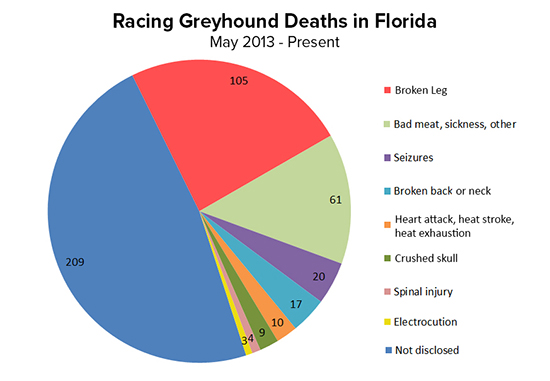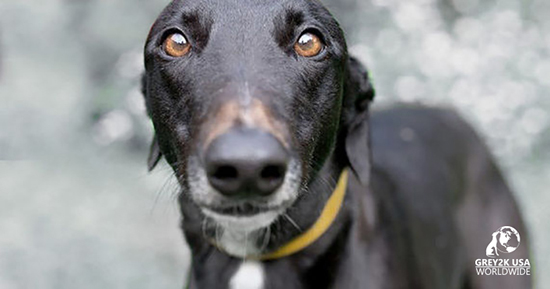 |
| Twelve of the remaining 18 American dog tracks may soon close. |
November 6, 2018 may well be the biggest moment ever in the worldwide fight to save greyhounds. On that day, the citizens of Florida will go to the ballot box and have the power to end the cruelty of dog racing in the Sunshine State once and for all. You can help, too! Please sign our petition for Florida greyhounds now.
It’s no secret
that greyhounds used in racing often pay with their lives. They break their necks, suffer paralysis and some are even electrocuted. A
greyhound named TNT
Quiet Riot “fractured her spine” and died at
the Sanford Orlando track on July 13, 2017. The very next day Rem’s
Carmex also broke her back
at another track in
Pensacola. PorPorPitifullMe was one of several dogs who fell into the live
rail and was electrocuted. On average a racing dog dies every three days in
Florida!
These poor dogs deserved better. They
were just 1 and 2 years old. In their deaths, we see the cost of dog racing in
its most heartless terms.
Since May 2013, nearly 500 young,
Florida racing dogs have lost their lives. Many suffered catastrophic injuries
and died on the spot. The others could have been saved! But instead of receiving medical care for
their broken legs or sprains, these gentle hounds were “given the needle.” Their
bodies were placed in plastic bags and tossed away, just like trash. Industry
reports call this “euthanasia” but we call it
cruelty.
Recent news about the doping of greyhounds with cocaine
is only the latest example of an industry that sacrifices animal welfare for
profit. In the first four months of 2017, there were eighteen cocaine positives at Florida’s
Orange Park Kennel Club. In January,
cocaine was found in five greyhounds at
Derby Lane, another Florida track.
 |
| Racing greyhound Mega Caliente falls at Orange Park in Jacksonville, Florida. |
But Florida is not alone in its cruel race-fixing schemes. Other states and countries are reporting
drug-positive dogs at levels never seen before in a wildly callous attempt to
make some of the fastest mammals on earth run even faster.
Life
in a cage
When not at the
track, racing greyhounds endure lives of
terrible confinement.
They are kept inside warehouse-style kennels inside stacked cages that are
barely large enough for them to stand up or turn around -- for twenty or more
hours a day! There are no toys for them and no play.
The minimum size
for dog track cages is 32 inches high by 31 inches wide by 42 inches deep, with
some slightly larger. According to the American Greyhound Council, greyhounds
stand between 23 inches and 30 inches tall at the shoulder and weigh between
fifty and eighty-five pounds. Using these dimensions provided by the industry,
this means that large greyhounds cannot stand fully erect in their cages.
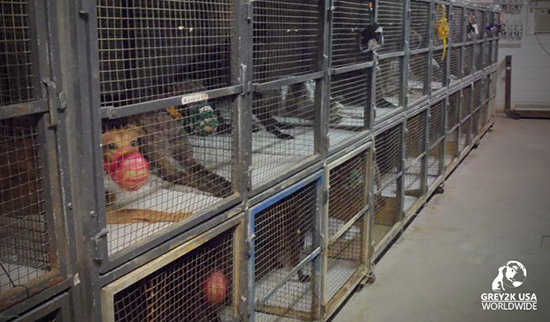 |
| Caged greyhounds at Daytona Kennel Club in Florida. |
Since there are
no required turn-out times, the only extended period that a racing greyhound is
outside of his cage is afforded when he is trucked over to the track to perform
several times a month. Otherwise, “home” is marked by the four sides of his
cage.
Greyhound
racing breeds misery
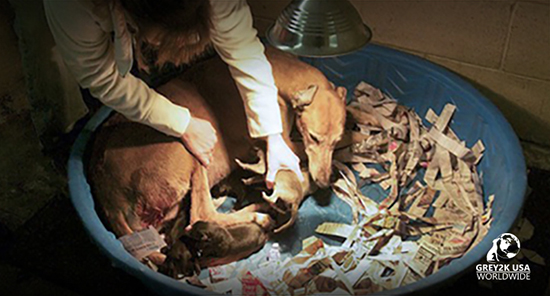 |
| A mother and her puppies at an American greyhound breeding farm. |
Another
essential problem with dog racing is that thousands of dogs are bred every year in an
effort to find younger, faster dogs. The older ones are then displaced, and
their very lives put in immediate jeopardy. Will they be rescued or will they
be destroyed? The lucky ones who do reach adoption will then displace other
needy animals (cats, dogs, rabbits, others) also seeking homes. In this
significant way, the racing industry aggravates a homeless animal population
which is already overwhelming and immensely sad. We believe that best answer
is to get to the root of the problem and end dog racing as quickly as possible.
A dying industry
Even as this cruelty continues, attendance is shrinking by
the year. The Association of Racing Commissioners
International reports a 70% decline in wagering on dog racing since
2001, the year GREY2K USA was founded. Where there were nearly fifty dog tracks
in fifteen states at that time, today there remain a total of eighteen
facilities operating in just six states. Similarly, state revenue from
greyhound racing continues to drop catastrophically. Between 2001 and 2014,
state dog race revenue declined by more than 82% nationwide. In Florida, the
country’s biggest dog racing state, regulatory costs have now exceeded revenues
by as much as $3.3 million yet dog tracks continue to receive tax breaks and
other incentives. States like West Virginia continue to subsidize live racing
with tens of millions of dollars per year. This is money that would be better
spent on schools, law enforcement, infrastructure and other important community
needs.
Our work
Our work
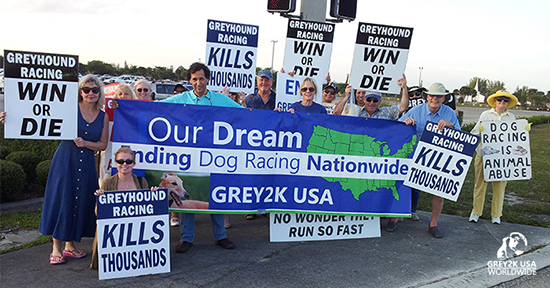 |
| Greyhound advocates rally for the dogs. |
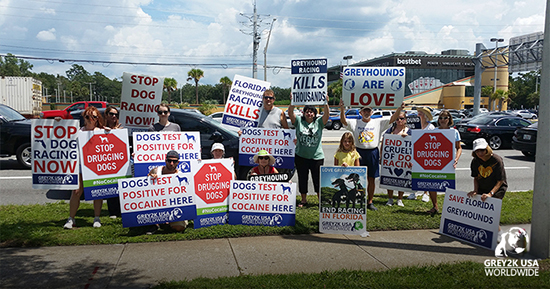 |
| Volunteers protest against cocaine-positive dogs found at Orange Park, Florida. |
All told, we have helped close two-thirds of all US tracks, and we are now
looking to apply our strategy to help end dog racing worldwide. Please sign our petition to the leaders of
the eight dog racing countries today.
The key to our efforts is a reliance on bona fide, official documentation only. Where
previous efforts to end dog racing often amounted to a “he-said she-said”
debate, today we let the greyhounds speak for themselves through their own track records and photographs.
You
can help the greyhounds
 |
| Lulu of Florida. |
My greyhound Gina is truly one
of the lucky ones. She gives life to this struggle and reminds me that every
dog deserves to be loved and protected. To learn more about dog racing, and to
work with us to save greyhounds, please go to GREY2KUSA.org.
Please sign our petitions, find us on Facebook
and Twitter, and join the team that is working to give greyhounds
the second chance they deserve.

